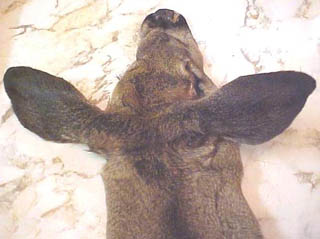
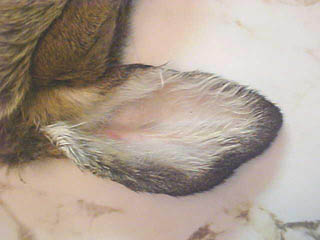
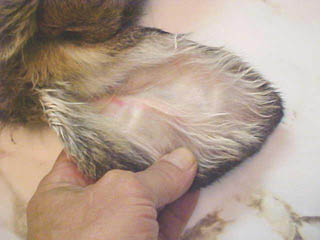
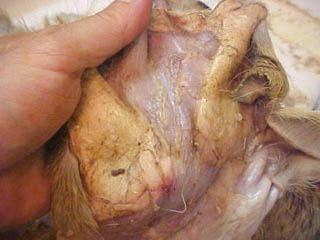
This article shows the effectiveness of STOP-ROT on skins that have been stored in the freezer for a period of time. This has proven to be one of the bonus applications of STOP-ROT. Frankly, such end results were not originally expected, or anticipated. My brother has been saying for years that he would rather be lucky than good. He just about has me convinced that he's right.
STOP-ROT likes the freezer. It's starting to look like as if it might be related to that little man that turns the refrigerator light out when you close the door. I frequently tell people that if a green cape is treated with STOP-ROT before freezing, a lot of times you will pull out a better cape than what you put in, and that's no joke.
A bottle of STOP-ROT put into a freezer that is set at 10 below zero, will take about three days to freeze, even then it is a "slushy hard". Same bottle can be put into the cab of a pick-up truck, with windows rolled up, sitting in the sun, with internal temps reaching 160 degrees, and still be as effective, if not more so, than it was to start with. I have to admit that I did not expect the STOP-ROT to take that kind of abuse.
The button buck shown here was taken the first week of November '02. The pictures you are about to see were taken after the cape was thawed on August 15, 2004.
The head was skinned out the day after the deer was shot. The cape was then treated with STOP-ROT on the flesh side, AND the ears, nose, eyes, and lips were soaked on the hair side. The cape was then rolled up in a ball, hair side out, with all the face and ears being in the center of the ball. It was then left in the freezer for 20 months.
A cape treated in the fashion as described above WILL take longer to thaw. This cape took just a little over 20 hours with the room temperature pushing 80 degrees F. This could be a real asset to you folks that are selling, and shipping green frozen skins and capes, or that are doing out of state hunts where you could have access to a freezer, or outside temperatures cold enough to freeze.
The first photo shows the cape immediately after thawing. Notice the backside of the ears.
By the way, when I skinned out this head, I brought it out through the mouth so that it would be a seamless mount.
You can see in the photos of the inside of the ears that they have a fresh, almost alive look. Note the suppleness of the ear on your right.
RESULTS OF LONG TERM FREEZING OF A STOP-ROT TREATED CAPE
by Glen Conley
Product Developer
WHITETAIL DESIGNER SYSTEMS, INC.
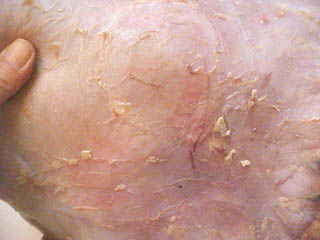
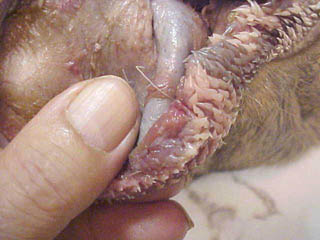
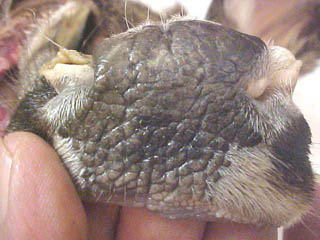
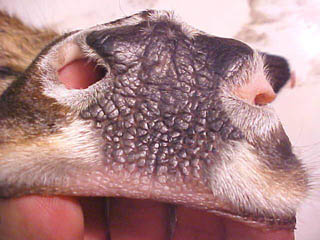
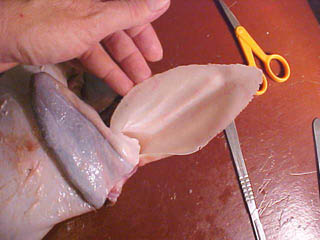
This next series of photos should give some of you Old Timers that haven't yet had the STOP-ROT Experience just a little bit of culture shock. I'm not out to give you a heart attack or any thing like that, just a little culture shock. We're coming back to the ears.
Now I did start opening the very back of the ears with ear pliers, but only until I got to the cartilage. After that, I just worked the skin off with my fingers, keeping a little pool of STOP-ROT running ahead of my fingers. I used scalpels and scissors to snip the tendons as I came to them.
Once I had the ears inverted, I came AROUND the edges to remove the inner ear skin.
I was at the point of thinking, "Let's run this baby wide open and see what she'll do!" I mean I am looking at skin going all the way down inside that ear canal. All the way down to where I cut the ear butts off close to the skull.
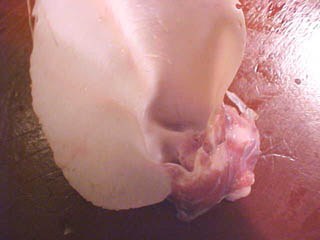
I kept running the pool of STOP-ROT in front of my finger tips, working skin loose as I went. Now I did wind up getting a tear down inside the ear canal, below the V, or conch with this ear. I was to the point I didn't have enough room for my finger, and tried to twist and pull it out. On the other ear, I used a blunt sculpting tool when I got to the tight place, and took the skin off with out tearing it. Granted, all that excess skin gets trimmed off, but it was a fun way to spend a Sunday afternoon.
The first photo, of the thawed cape, was taken at 2:07 p.m. Remember, my room temperature was pushing the 80 degree mark.
Notice in the photo of the nose pads, the one on the right has already been shaved down to the black on the flesh side. I went ahead and completely fleshed the lips, split and thinned the eyelids, and thinned the whole cape over the fleshing wheel. After the cape was pickled, it took minimal shaving, actually just about enough to further evening the cape out.
There is a point on a STOP-ROT treated cape that it will flesh and shave beautifully, but not to the point I personally would consider it ready to mount, even though it might appear so at the time. STOP-ROT does however work in combination with dry preservatives.
I left the cape hanging over my fleshing beam with the flesh side out until 1:00 a.m. the following morning. It was starting to air dry more than I cared for at that point, and I really didn't want to rehydrate to put it under salt. So at that point, I salted it, rolled it up into a ball, allowed the salt to draw fluids for several hours, and then put the cape into the pickle later that morning.
Once I realized the positive effect of STOP-ROT on frozen capes, I had to start leaving stuff in the freezer to test over different time periods. Everything so far has surprised and pleased me.
I still have stuff of my own in the freezer that was STOP-ROT treated and frozen three years ago. It is my fantasy to some day get those out and mount them, if the little man that turns the refrigerator light out doesn't go ahead and do them first.
The cape shown in the above article is shown as a finished mount on a form that was a doe form altered to fit up a button buck.
These next two photos will show you what happens with that light treatment of STOP-ROT after thawing. The photo on your left was taken right after the cape thawed, the one on your right was taken a couple of hours or so after the STOP-ROT treatment.
This photo shows the bottom lip and papillae after thawing, and followed up with another light coat of STOP-ROT.
The photo on the left is a view of the flesh side of the cape. The one on the right is the extent of freezer burn damage. No problem. I just treated the whole cape with STOP-ROT after it thawed. Just that treatment alone pretty well took care of the dryness that you see here.
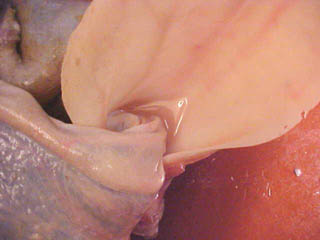
STOP-ROT is available from these taxidermy supply distributors and tanneries: Order on-line from high lighted suppliers!
RESEARCH MANNIKINS 1-800-826-0654
Van Dyke's Taxidermy Supply 1-800-843-3320
Wildlife Artist Supply Company 1-800-334-8012
Quality Taxidermy Supply 1-888-527-8722
AEWS Taxidermy Supplies 1-800-529-3470
Taxidermy Arts Supply TASCO
Lonestar Wool & Fur 1-919-989-2000
SIVKO FUR, INC. 1-607-698-4827
James Taxidermy Supply (formerly Kings)
1-662-286-5133
WHITETAIL DESIGNER SYSTEMS 1-866-849-9198